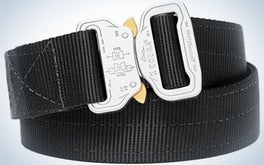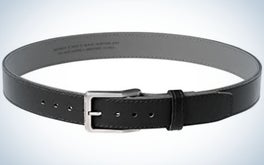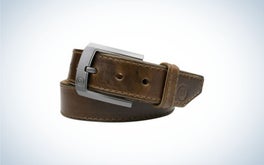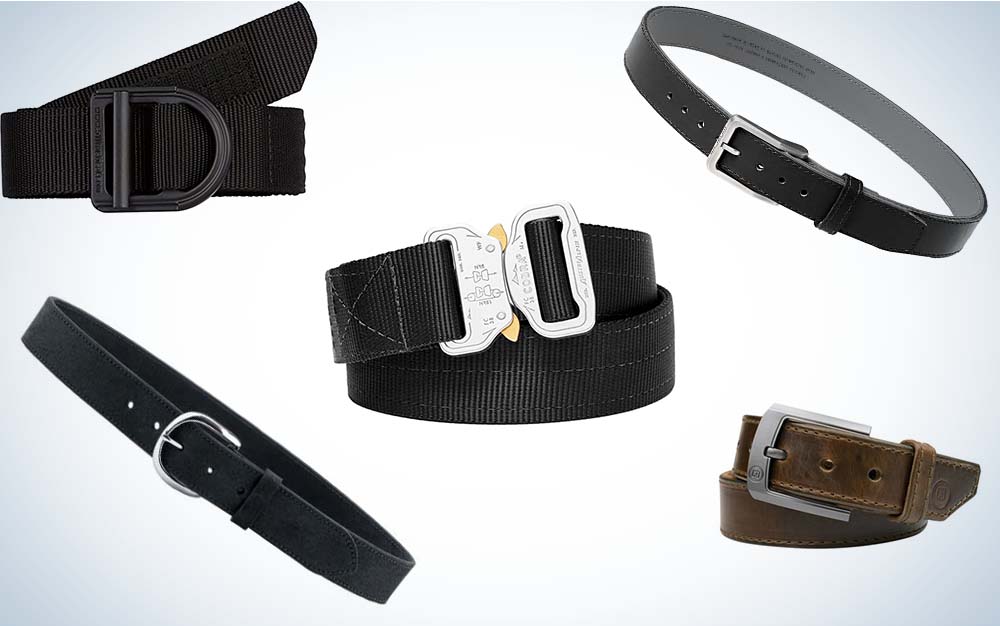| Best Overall |

|
Klik Belts 2-Ply Tactical Belt | SEE IT |
LEARN MORE
|
Summary
The incredibly durable two-ply webbing and patented Cobra buckle make this a solid option for serious wear and use. |
| Best for EDC |

|
Magpul Tejas “El Original” Gun Belt 2.0 | SEE IT |
LEARN MORE
|
Summary
Designed for everyday carry, this belt is built to perform when you need it most but is also suitable for regular wear even when you’re not carrying. |
| Best for Concealed Carry |

|
Crossbreed Holsters Executive Gun Belt | SEE IT |
LEARN MORE
|
Summary
The idea of concealed carry is to blend in, and the Executive Gun Belt from Crossbreed won’t betray your efforts. |
We may earn revenue from the products available on this page and participate in affiliate programs. Learn more ›
Having an assortment of high-quality gun belts is important if you’re going to carry a gun. Yes, I’m saying that your choice of the belt is even more important than your choice of the holster. You see, it doesn’t matter how well trained you are, or how good the retention and concealment of your holster is, if you can’t keep the holstered gun securely in place on your body during whatever activities you may be doing throughout the day.
Just as there is a variety of different activities you may be doing, there is a variety of different quality gun belts on the market. While they all do the same basic thing – hold your holstered gun securely in place — they may not all be appropriate for every setting. Having the right one for each scenario means you’ll be prepared whatever your activity.
With that in mind, we’ll go over some of the best gun belts on the market right now and help you decide which one might be right for you.
- Best Overall: Klik Belts 2-Ply Tactical Belt
- Best for Concealed Carry: Crossbreed Holsters Executive Gun Belt
- Best Under $50: Galco CLB5 Carry Lite Holster Belt
- Best Nylon: 5.11 Tactical Trainer Belt
- Best for EDC: Magpul Tejas “El Original” Gun Belt 2.0
How I Picked The Best Gun Belts
Like many other items associated with firearms, gun owners tend to accumulate multiples of gun belts. I’ve owned at least a dozen different ones over the last decade and have settled on three that are now part of my regular rotation. When it comes down to picking the right one for me, I evaluate the best gun belts available using the following criteria:
- Materials: Whether it’s nylon or leather, stainless steel or nickel, are the materials that make up this belt of a high enough quality that they’re going to live up to years of use?
- Thickness: Is this belt thick enough to provide the proper support I need without being so thick as to become cumbersome or difficult to put on or remove?
- Cost: Is this gun belt a good value for the price it’s going to cost?
The Best Gun Belts: Reviews & Recommendations
Best Overall: Klik Belts 2-Ply Tactical Belt
Why It Made the Cut: The incredibly durable two-ply webbing and patented Cobra buckle make the Klik Belts Tactical Belt a solid option for serious wear and use.
Key Features
- Triple stitched for extra strength
- Double-layer construction offers plenty of rigidity
- Fourteen different color combinations
Pros
- Super strong Cobra buckle opens in a flash
- You can add optional hook and loop fastener to keep the tail in place
- Anodized 7075 aluminum buckle and industrial strength webbing for a lifetime of hard use
Cons
- Only available in 1.5” width
- Adjustment tail is 11” long, so that’s a lot of extra material
The 2-Ply Tactical Belt from Klik Belts uses their patented Cobra buckle, which they say is the strongest in the world. Despite its incredible strength, it can be removed in a flash thanks to the innovative buckle. And being built using anodized 7075 aluminum, it’s sure to last a lifetime.
Unlike the version of this belt designed for casual wear, this belt is constructed with two-ply webbing. This double-layer is rigid in the vertical direction but pliable in the horizontal, making it an excellent gun belt. Instead of having to factor in extra length for your gun when determining what size to order, the Klik Tactical Belt has an extra-long tail that can be adjusted for different setups without having to buy a belt that’s bigger than you need.
Best for Concealed Carry: Crossbreed Holsters Executive Gun Belt
Why It Made the Cut: The idea of concealed carry is to blend in, and the Executive Gun Belt from Crossbreed won’t betray your concealed carry efforts.
Key Features
- Nylon core for durability
- Completely customizable
- Available in two widths to fit a variety of belt loops
Pros
- Lots of options: two widths, four types of leather, three buckle options, and five thread colors to choose from
- Nylon core provides durability without unnecessary stiffness
- Discreet “CB” on the buckle won’t betray the belt’s true purpose
Cons
- Crossbreed’s lifetime warranty doesn’t cover their belts
Crossbreed has been making excellent concealed carry holsters, so it only makes sense that they make an excellent concealed carry belt. Their Executive Gun Belt is a fashionable and professional option for those who favor a more polished look that says “corner office” instead of “concealed carry.”
Available in 1.25” and 1.5” widths, this belt uses two pieces of matched cross grain seven-ounce leather with a woven nylon webbing strap liner attached with industrial adhesive. The result of this new design is a strong belt with superior support for your carry needs, while still offering flexibility for comfortable everyday wear. The finished and refined look of this belt will find a niche in your business-dress wardrobe as well as your daily carry.
Best Under $50: Galco CLB5 Carry Lite Holster Belt
Why It Made the Cut: Great products at even greater prices are hard to find, but the Galco CLB5 Carry Lite Holster Belt manages to indeed be a great product at a great price.
Key Features
- Made with double-thick leather
- Nickel-plated brass buckle
- Constructed of premium center-cut steerhide
Pros
- Costs just $49
- Lots of adjustment holes
- Plain design won’t betray the true purpose
Cons
- Only available in 1.5” width
- Most sizes are backordered
Galco knows leather gun products, as their holsters are trusted the world over. So it only makes sense that they know how to make a quality leather gun belt. The double-thickness premium center-cut steer hide allows the CLB5 Carry Lite Holster Belt to offer economy, function, and good looks.
With a total of seven holes set one inch apart, there’s plenty of room for a wide adjustment range if you carry different guns in different holsters in addition to adding or subtracting other belt-carried gear. To determine the correct size to order, measure your existing belt from the end of the buckle to the hole you are currently using. That measurement will be the size you should order for your new Galco belt. Because it’s sized to the center hole, you’ll be able to adjust for each of your carry rigs easily.
Best Nylon: 5.11 Tactical Trainer Belt
Why It Made the Cut: The 5.11 Tactical Trainer Belt is proof positive that nylon is suitable for heavy-duty uses far above and beyond what you used to think was possible from a fabric often associated with pantyhose.
Key Features
- Available in six colors
- Fade and rip-resistant
- Sliding buckle is infinitely adjustable
Pros
- Converts to a tie-down, carry strap, or emergency harness
- Hook and loop fasteners allow for extra adjustment
- Stainless steel buckle is rated to more than 2.5 tons
Cons
- Sizes run small, so be careful when ordering
The 5.11 Tactical motto is “Always Be Ready.” With their Trainer Belt, you always will be. The consistent choice of law enforcement professionals for years now, the 5.11 Tactical Trainer Belt is built from ultra-strong nylon mesh with heavy-duty stitching. The belt features a solid stainless steel buckle, tested for tensile strength up to 5,100 pounds.
The sliding nature of the buckle makes it easy to get the fit dialed in exactly where you want. Hook and loop fastener on the tail keeps it tucked in, so it won’t get snagged or impede movements. Available in six different colors, the fabric is resistant to fading so that it will look good even after years of hard wear. As an added bonus, the belt can be converted into a tie-down, carry strap, or emergency harness in case you need to put the 5.11 motto into play in the real world.
Best for EDC: Magpul Tejas “El Original” Gun Belt 2.0
Why It Made the Cut: Designed for everyday carry, this belt is built to perform when you need it most but is also suitable for regular wear even when you’re not carrying.
Key Features
- Revamped from the original design
- Made in the USA
- Available in three colors
Pros
- Gun belt rigidity with dress belt comfort
- Flexible polymer layer provides extra support without unnecessary stiffness
- Flat belt buckle retains a slim profile for less printing
Cons
- Tight rolling and excessive bending may strain the leather and weaken the stitching
Magpul has revamped their Tejas “El Original” Gun Belt 2.0 (hence the 2.0) to make it even better than the previous version. It provides gun belt rigidity with dress belt comfort and offers stretch and sag-free performance. At the office or on the beat, you’ll be able to carry comfortably without drawing attention to yourself.
Made from 100% North American bull hide, the Tejas “El Original” 2.0 is backed by a supporting layer of a flexible polymer. Part of the revamp includes a new easily removable belt buckle that’s engineered with a sleek profile design that sits flat against the waist and helps reduce printing when you’re carrying. The belt comes in even sizes from 32”-44” in your choice of black, chocolate, and light brown. Best of all, it’s made in the USA.
What to Consider When Choosing a Gun Belt
Just as you likely own more than one holster, you’ll likely end up owning more than one gun belt. In the same vein as the holsters, different belts serve different purposes, so don’t feel like you’re locked into one belt from now until it gives up the ghost. Instead, consider if your current gun belt is doing what you need it to do. If not, it’s time to start shopping for a new one.
Obviously, the final decision is up to you, but if you’re going to buy a new gun belt, then here are some of the things you should think about before parting with your hard-earned money:
Materials
Do you want a leather belt or a nylon belt? How about Velcro, clips, or traditional buckle closures? Those are all solid options from which to choose, but they’ve all got benefits and drawbacks.
Environment
Where will you be wearing the belt and what will you be doing while you’ve got it on you? Will you be in a tactical training class or in a white-collar office setting? There are belts designed to perform the same but blend differently depending on where you’re wearing the belt.
Of course, safety is always a concern. Be sure to review the 10 rules of gun safety from the National Shooting Sports Foundation. And review our list of the best guns for suggestions.
Price
An expensive belt isn’t always the best belt. Be sure to look at the materials the belt and hardware are made of and see if you think they provide the quality and performance you’re expecting at a price you think is reasonable. If not, keep shopping; the right option is out there.
FAQs
Q: Are gun belts comfortable?
Yes, a good gun belt is comfortable. Note, however, that I said a “good” gun belt. They’re not all created equal, and you may find that you prefer certain materials over others. Make sure you take the time to find the right belt for you as it is imperative that it be comfortable enough for all-day wear. If not, you won’t want to put it on, defeating the entire purpose of the gun belt.
Q: Are gun belts worth it?
Yes, gun belts are worth it. The standard off-the-rack belt from a department store isn’t designed to withstand the extra weight that comes with carrying a gun and other gear day in and day out. They also can’t handle the additional wear and tear. If you don’t invest in a good gun belt the first time around, you’ll just end up throwing good money after bad as you buy one subpar belt after another.
Q: How long do gun belts last?
A good gun belt should last for years and years. Some people have even reported their gun belts lasting a decade or more. Just like any other product made from durable, quality materials, you can expect a gun belt to last for a long time so long as you take proper care of it. A good gun belt is an investment, and like most investments, they’re long-term propositions.
Final Thoughts on the Best Gun Belts
Just like the guns and holsters that they support, having a good gun belt is paramount. But even the best gun belts aren’t a “one size fits all” proposition, so you may need multiple options depending on how you plan on using them. Consider how and where you’ll be wearing it, the materials it’s constructed from, and pick out a belt that works for that scenario based on the preceding information.
Why Trust Us
For more than 125 years, Field & Stream has been providing readers with honest and authentic coverage of outdoor gear. Our writers and editors eat, sleep, and breathe the outdoors, and that passion comes through in our product reviews. You can count on F&S to keep you up to date on the best new gear. And when we write about a product—whether it’s a bass lure or a backpack—we cover the good and the bad, so you know exactly what to expect before you decide to make a purchase.






